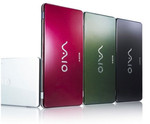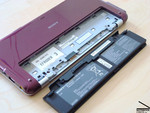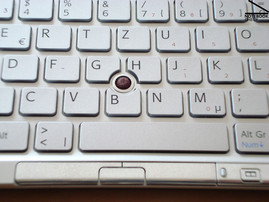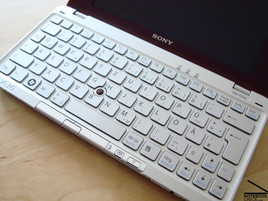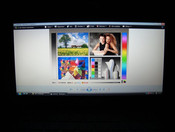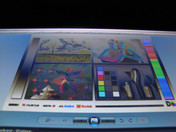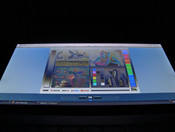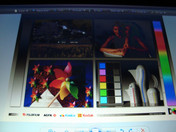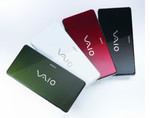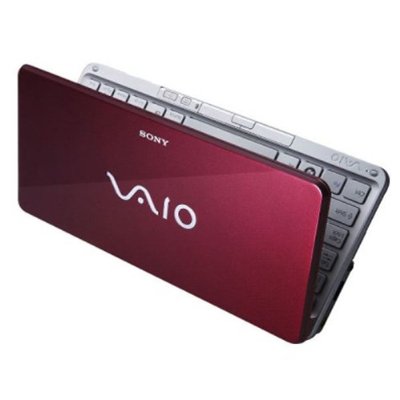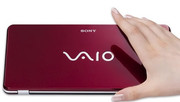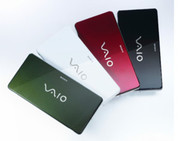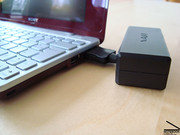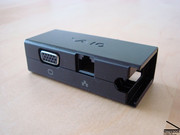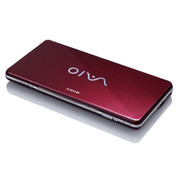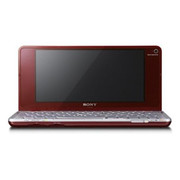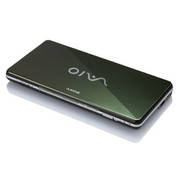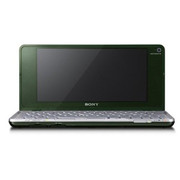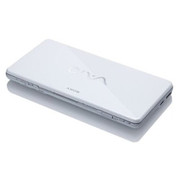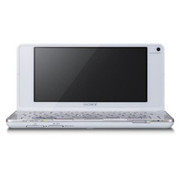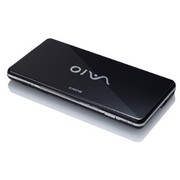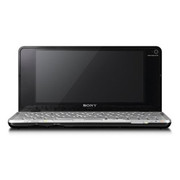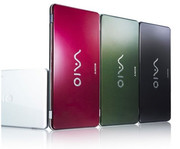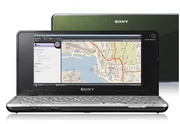Review Sony Vaio VGN-P11Z/R Mini-Notebook
„Don’t call it a netbook!“
Sony launches a "PC system" of a special kind with the Vaio VGN-P11Z. The manufacturer demanded that it's not a netbook in the press release. "Don't call it a netbook!" it was declared then.
It certainly belongs in the league of the mini-notebooks, optically and from its proportions. The reserved connectivity and the display size are attributes, which suggest a netbook. Even the built in hardware is partly identical to that of a netbook. Why then, not simply call this device a netbook?
This question isn't simple to answer. Even if everything points to it at first view, there are a few things that distinguishes or rather makes the Sony Vaio VGN-P11Z "special" or different to competitor products, no matter if they're netbooks or subnotebooks. We will peruse these particularities in the following review, as well which strengths and weaknesses our test device from Sony displays.
The manufacturer treats the Vaio P series to its own rubric on their homepage and labels the in-house product, the VGN-P11Z, as an "ultraportable lifestyle PC"
Case
The first particularity of the new Vaio P series is with certainty the shape of the case, which isn't very much bigger than a long envelope. With the measurements 245x120x19.8 millimeters (breadth x depth x height) the Sony Vaio VGN-P11Z distinguishes itself considerably from other netbooks on the market. Not only that the new sprout with not even two centimeters construction height is a very slim escort, but also especially because the depth is 120 millimeters and therefore has quite a considerable advantage compared to the competition with a weight of merely 0.638 kilogram including the battery. The manufacturer, Sony, has done excellent work in consideration of miniaturization.
The case depth of exactly 120 millimeters is probably not a coincidence. Take a guess at how large a common inside sports coat pocket is? – Bingo. A bit more than 12 centimeters. The Vaio P11 lets itself be stowed away and carried around in there without any problems. But it has to be noted that for longer excursions even the slightly more than 600 grams of notebook weight are too much in this case.
The Vaio P series isn't only an eye-catcher because of its proportions, but especially because of the optical styling in the high gloss polished finish in four different colors. First there is the Sony Vario P series in the classic colors of black (VGN-P11Z/Q) and white (VGN-P11Z/w), which the manufacturer spontaneously calls Ebony Black and Ivory White. For clients who want more color, the ultraportable PC is additionally available in wine-red (VGN-P11Z/R) and green (VGN-P1Z/G), which is labeled as Volcano Red and Forest Green from Sony. Our test sample was the model in Volcano Red, which could completely convince us. Very chic and elegant, and especially small and compact.
We haven't any reason to complain in regards to case stability and on the workmanship of the VGN-P11Z/R, either. The edges are well and cleanly ground, the corners are rounded and the single high quality components are flawlessly assembled. We didn't notice any unpleasant creaking noise when handling the case of the small electronic companion. Possible weak points, i.e. the wrist rests which might give in at point pressure, are omitted due to the slender construction depth of the ultraportable PC. Only the display's back side gave in slightly, which is not worth mentioning, though.
You should take care of the high quality finish to a greater extent instead, which is rather susceptible for fingerprints on the one hand and on the other also should be protected against damage through a transport bag. This is, much to the annoyance of potential customers, not included and can/has to be ordered at Sony. There is definitely not a lack of additional accessories for the VGN-P11Z – at a price, of course.
A further particularity with which the Sony Vaio P series distinguishes itself from the broad mass is the 8 inch sized UWXGA display, which is securely held in place from two small hinges. Further details about the display later, though. Additionally, the ultra-compact PC does without closure mechanisms.
Connectivity
The Sony VGN-P11Z bids only the most necessary connections. The small case doesn't offer very much more space for further interfaces. The connections, which the very compact VGN-P11Z has, are well distributed around the case and easily accessible.
Besides the power and WLAN switch, an SD CardTM socket as well as a separate port for a Memory StickTM Duo, Memory StickTM PRO Duo, suitable for high velocity data transfer, is found on the front.
The right side has a place for an USB plug and also a port replicator connection in order to, i.e. connect the included dongle, with which Sony extends the given ports by an additional LAN and VGA-out connection. The LAN socket as well as the VGA port work perfectly. A 22" widescreen TFT could be used without problems at the maximum resolution of 1680x1050.
The left side is occupied from the power socket, a further USB port and the audio-out for connecting headphones.
The back side is free from any connection possibilities, however, because the built in battery uses the whole breadth of the VGN-P11Z.
As it has become a general standard, Sony's ultra-compact computer also has a Motion Eye webcam, which is found in the upper right display corner and with which video conferences are also possible.
The Sony Vaio VGN-P11Z also has a Bluetooth 2.1 + EDR and UMTS/HSDPA besides LAN and WLAN 8.2.11 b/g/n (Atheros AR928X Wireless Network Adapter). Thanks to the integrated 3G-WWAN techonology Vaio "Everywair", you are able to surf in the internet from everywhere in the world with the Vaio P series, with a sufficient reception and a correlating contract it's to be understood, of course.
Our test sample has a 60 GB hard disk with 4200 rotations per minute from Toshiba (MK6028GAL ATA Device) as a mass storage, which contains a hard disk shock protection (G-Sensor HDD® Shock Protection).
Input Devices
Sony also varies in comparison to the competition in regards to the input devices. Despite the small size or rather depth, the VGN-P11Z has a very generous keyboard. The P series keyboard makes an unproblematic typing with both hands possible. Typing turns out to be very pleasant, even if we think that the pressure point turns out to be somewhat sluggish. We are by and large rather satisfied with the layout of the keyboard. We find that merely the right shift key turned out a bit too short. We frequently hit the arrow key on the right beside the shift key in the practical test. With enough practice this shouldn't be a too big of a problem, though.
A touchpad as a mouse substitute can't be found because the Sony Vaio VGN-P11Z doesn't have wrist rests. Instead, the ultraportable PC has a pointstick (Alps StickPointer for Vaio) to navigate the mouse cursor. But our doubts at the start luckily evaporated after a certain accommodation period. Even if you "overreach" the button at first tries, little by little you acquire a better sense for this small stick, which is found in the middle of the keyboard.
This reacts surprisingly very good and with the right dexterity also very precise. The pointstick can also execute a left click. Alternately the VGN P11Z has, of course, two slim and elongated chrome mouse keys directly on the front edge of the keyboard.
Display
One of the new Vaio's particularities is definitely the extremely high resolution UWXGA display of the merely 8 inch sized device. This has an X-black LCD with LED technology and can display high resolution images very sharp and with the maximum of 1600x768 pixels on the screen.
Because everything is shown very minute through the high resolution on the comparably small surface, many will certainly have their problems with that and for many potential clients it might be a knock-out criterion for buying the VGN-P11Z. It convinced us anyway.
At the start we had our doubts if Sony didn't overdo it and went too far with the display, but after a short accommodation period you get used to the fine resolution. If the presentation is too small nonetheless, then you can simply put things right with the integrated magnifying glass or the zoom function.
Unfortunately, the VGN-P11Z has a reflective display, which entails advantages in regards to color quality, but makes outdoor use, despite satisfactory display brightness, rather difficult.
A further flaw of the display is the fairly inconstant illumination. The brightest point we detected could be found in the upper middle area with 252.4 cd/m2. In the lower right corner we could merely measure 185.7 cd/m2. As you can see from the evaluation, the display illumination is very good in the upper area and decreases steadily in the lower area.
On the whole, the merely eight inch small screen left us with a good impression, despite the slip-up in regards to illumination.
| |||||||||||||||||||||||||
Brightness Distribution: 74 %
Contrast: 166:1 (Black: 1.3 cd/m²)
There's not much to complain about when it comes to the viewing angle stability. Especially the horizontal viewing angle is particularly generous. On the vertical plane it doesn't look as good anymore, but allows for a certain play anyway.
Performance
A Z520 Atom CPU with 1.3 GHz clock rate from Intel, two GB RAM (1x2048 MB DDR-2 onboard), a 60 GB hard disk with 4200 rotations and a mobile Intel Graphics Media Accelerator 500 graphic chip is the base for performance.
Although we were quite satisfied with the Sony VGN-P11Z till now, in regards to the offered performance it looks rather bleak. At this instant, the benchmark run throughs aren't so important for us but fundamental things like i.e. booting the operating system, opening a browser or even only a file, copying, etc. The Sony VGN-P11Z doesn't look very good, unfortunately.
Cold starting the system can take a good five minutes or more. Short waiting times have to also be counted with when starting Explorer or even opening a file, which make a smooth execution rather difficult.
We believe that this is due to the unfortunate choice of the built in hardware in combination with the applied operating system. The built in Atom Z520 processor with merely a 1.3 GHz clock rate might be economical but the CPU is fairly strongly loaded at rather simple tasks so that the system stagnates until the process is finished. The pretty lame hard disk with only 4200 rotations per minute probably has a part in the lethargic conduct of the VGN-P11Z, just as well as the performance-intense operating system Windows Vista.
A faster hard disk or even an SSD, a more efficient CPU or even the use of the well-tried Windows XP would have already done something for the better. An alternative would, of course, have been Linux as the OS.
Working on the device in its current state could turn into an ordeal. Those who don't mind these "minor" things will have their pleasure with the VGN P11Z. The ultra-compact PC from Sony is capable of internet surfing, writing mails or letters, office applications or even playing music, but with the mentioned short breaks.
We also had our problems in the benchmark run throughs. The PcMark05 was interrupted midstream, and that more than once. But those who only want to play multimedia files luckily don't have to wait till Windows Vista is booted, but can access the files directly thanks to the Instant-On operating system Xross Media Bar.
| 3DMark 2001SE Standard | 1141 points | |
| 3DMark 03 Standard | 4113 points | |
Help | ||
| Cinebench R10 | |||
| Settings | Value | ||
| Shading 32Bit | 22 Points | ||
| Rendering Multiple CPUs 32Bit | 635 Points | ||
| Rendering Single 32Bit | 431 Points | ||
Emissions
System Noise
The Sony VGN-P11Z is a very quiet companion due to the very modest Intel Atom Z520 processor, which is barely audible. The system noise of the ultraportable PC can surprise us positively not only in idle mode but also under load, like the measured values confirm. Our test device sways between 29.8 dB(A) and 31.4 dB(A).
We were particularly surprised by the VGN-P11Z's noise development under constant load or more precisely from the omitted noise development despite 25 minutes of full CPU load. According to our measuring device the noise increases to merely 31.9 dB(A). We think this is a value to be more than content with.
Noise level
| Idle |
| 29.8 / 29.8 / 31.4 dB(A) |
| Load |
| 31.9 / 31.9 dB(A) |
 | ||
30 dB silent 40 dB(A) audible 50 dB(A) loud |
||
min: | ||
Temperature
The low system noise emission of the Sony VGN-P11Z isn't available without paying an appropriate price. The ultra-compact PC heats up on the left side of the keyboard under constant load with Prime95 to a still acceptable 36.8 degrees Celsius.
On the test device's bottom side it gets a bit hotter. We could establish 42.4 degrees Celsius on the bottom left side.
(+) The maximum temperature on the upper side is 36.8 °C / 98 F, compared to the average of 33.1 °C / 92 F, ranging from 21.6 to 53.2 °C for the class Netbook.
(±) The bottom heats up to a maximum of 42.4 °C / 108 F, compared to the average of 36.6 °C / 98 F
(+) The palmrests and touchpad are reaching skin temperature as a maximum (35.8 °C / 96.4 F) and are therefore not hot.
(-) The average temperature of the palmrest area of similar devices was 29.3 °C / 84.7 F (-6.5 °C / -11.7 F).
Loudspeakers
The built in loudspeaker do a good job and do their duty aptly, as long as you don't expect too much because the given sound quality does turn out rather modestly on the whole. Those who put emphasize on output, deep and full basses and clear sounds will have to be let down. The ultra-compact PC from Sony isn't capable to manage this by itself. We advise the acquisition of high quality headphones, with which this weakness of the VGN-P11Z can be equalized without further ado.
Battery Life
The Sony VGN-P11Z has a lithium-ion battery with a capacity of 2100 mAh (16 Wh; 7.4 Volt), with which support our test device survived up to 4 h and 17 minutes without a power socket (BatteryEater Reader – min. brightness, WLAN off, max. energy savings systems).
Under load in the BatteryEater Classic test the energy donator ran up to 2h and 7 minutes until it was out of puff. WLAN and display brightness was at maximum at this.
The Sony VGN-P11Z can grant a runtime of up to 2h and 49 minutes at wireless WLAN surfing with good to maximum brightness and activated energy savings systems, which is still an acceptable value.
| Off / Standby | |
| Idle | |
| Load |
|
Key:
min: | |
Verdict
The Sony VGN-P11Z is without a doubt an optically impressive device with its very elegant and chic appearance. Especially because it distinguishes itself through its elongated, small and compact form from other netbooks, it will attract many curious glances.
The P11 also has all standard communication equipment such as LAN (included dongle) and WLAN. Additionally Bluetooth 2.1 + EDR and UMTS are also offered. According to own internet reports, it should also have a GPS module, which makes the Sony P11Z to a mobile navigation system, too.
The high resolution UWXGA display with 1600x768 pixels is very impressive. But all of this can't hide the efficiency deficits of our test candidate. The waiting time at booting is definitely too long and the use under Windows Vista too stagnant.
But for those who don't mind that and put more emphasize on an elegant, compact optic with a very good workmanship, and also are looking for a high resolution display in a 8 inch form factor should throw a look on the Sony VGN-P11Z. The retail price is set currently at about a proud 1000.00 Euros.





